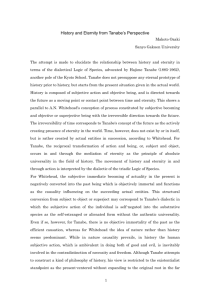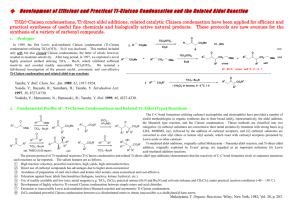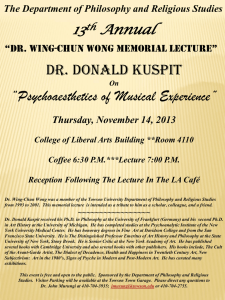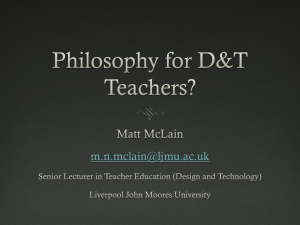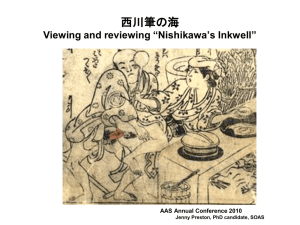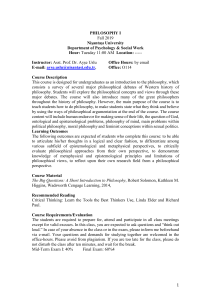Hayashi
advertisement
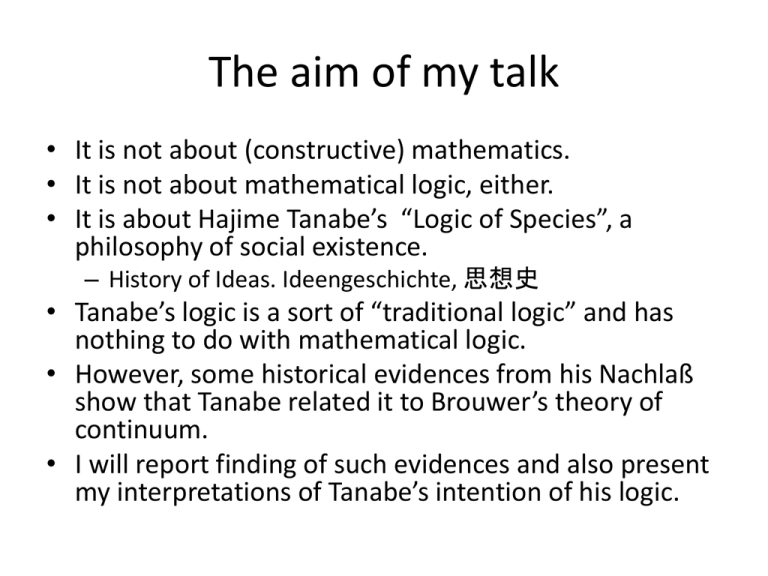
The aim of my talk • It is not about (constructive) mathematics. • It is not about mathematical logic, either. • It is about Hajime Tanabe’s “Logic of Species”, a philosophy of social existence. – History of Ideas. Ideengeschichte, 思想史 • Tanabe’s logic is a sort of “traditional logic” and has nothing to do with mathematical logic. • However, some historical evidences from his Nachlaß show that Tanabe related it to Brouwer’s theory of continuum. • I will report finding of such evidences and also present my interpretations of Tanabe’s intention of his logic. Hajime Tanabe • Hajime Tanabe (田辺元, 1885-1962) is the first philosopher of science in Japan. • His books on sciences and mathematics were quite popular among high school and university students before WW2. • His writings contributed much to popularize the foundations of mathematics in Japan in 1910-20’s. • He is often regarded most prominent among philosopher s of “Kyoto School” only second to Kitaro Nishida, the founder of the school. Kyoto School of philosophy • The Kyoto School is a group of 20th century Japanese philosophers from Faculty of Letters (now Graduate School of Letters) of Kyoto University, who developed original systems of thought by drawing on the intellectual and spiritual traditions of East Asia, Buddhism in particular, as well as on the methods and content of Western philosophy. (Quoted and edited by Hayashi from the article “The Kyoto school” of Stanford Encyclopeida of Philosophy ) • Wikipedia • Prominent members: Kitaro Nishida, Hajime Tanabe, Keiji Nishitani, Testsuro Watsuji, Syuzo Kuki, Kiyoshi Miki, … Logic of Species • After Nishida’s retirement in 1928, Tanabe succeeded the chair of professor of philosophy at the Faculty of Letters, Kyoto university, and he became one of the most influential university professor of the time. • Although he had only several official students, his lectures attracted more than 200 participants. Most of them were students and professors from other faculties and universities nearby. • What made him so famous would be a series of papers on “Logic of Species” 種の論理 published from 1934 to 1941 (another paper is published in 1946, after his retirement 1944 and also the defeat of Japan 1945.) Logic of society • Logic of Species is a traditional logic in the sense of Aristotle and German idealism. In Aristotelian and Hegelian logic, species are merely subsets of classes, and individuals are the smallest species, and classes are collections of individuals. • However, the notion of species has a unique place in Tanabe’s logic. Logic of Species was intended as a social philosophy to rival Marxism prevailing then among Japanese young intelligentsia, especially students of Kyoto University. Species are not merely collections • Species in his sense are racial groups, racially homogeneous societies or nations. Thus, species are not merely collections of independent individuals. • For Tanabe and most members of Kyoto School, it was a shared assumption that democratic western societies and cultures were in the process of a final decline and they and their basic assumption, individualism, must be overcome. Thus, species comes first rather than individuals. • Tanabe intended to give a philosophical foundation to such an anti-individualistic ideology, and what made him so famous would be such a character of his logic. Nonetheless, liberty for individuals! • Nonetheless, Tanabe laid another condition for the logic, the liberty of individuals must be assured in a way. • A species must not be a mere set of individuals, but each individual must be “attached” into it in some sense. Nonetheless, an individual has liberty to oppose to its species so that its opposition or the conflict (contradiction) between these two entities brings “Aufhebung”. • Logic of Species was intended to be such a kind of dialectics. Brouwerian continuum and Tanabe • Tanabe’s notes for his “special lecture course” 特 Tanabe got acquainted 殊講義 of 1934 kept in Gunma University Library with Becker and Heidegger, suggest that “Logic of Species” was conceived when he studied through the course. philosophy in Germany. • He seems to have had anticipation of some kind of relationship to Brouwer’s theory of continuum after Oskar Becker’s description the theory in Mathematische Existenz. Untersuchungen zur Logik und Ontologie mathematischer Phänomene, 1927, which was influenced by Heidegger’s Sein und Zeit, 1927. Brouwerian continuum as a model notion of choice • The descriptions onThe Brouwerian continuum are found sequence was even in Tanabe’s first paper on Logic of Species (1934), introduced in 1924. however, the descriptions are very vague and superfluous. • Some evidence show that Tanabe acquired Heyting’s book Mathematische Grundlagenforschung Intuitionismus, Beweistheorie, 1934, in the end of 1934 or early 1935. • In the book, he found that Brouwerian continuum is a mathematical “model” which satisfies the two conditions for his logic. Comparison Brouwer • Species • Menge (spread) • A “Menge” comes first as a rule, and then each real number is generated by free choices. Tanabe • Class • Species • A nation comes first, and each individual comes out from the nation. • Individuals have liberty. Further Researches • Neo-Kantian influences – Aspects of anitscientism, historicism – Cohen’s philosophy of infinitesimal – Social aspects of neo-Kantian movement • To the history of modern mathematics in the broader context – Jeremy Gray, “Plato’s Ghost” – Herbert Mehrten “Moderne, Sprache, Mathematik”
